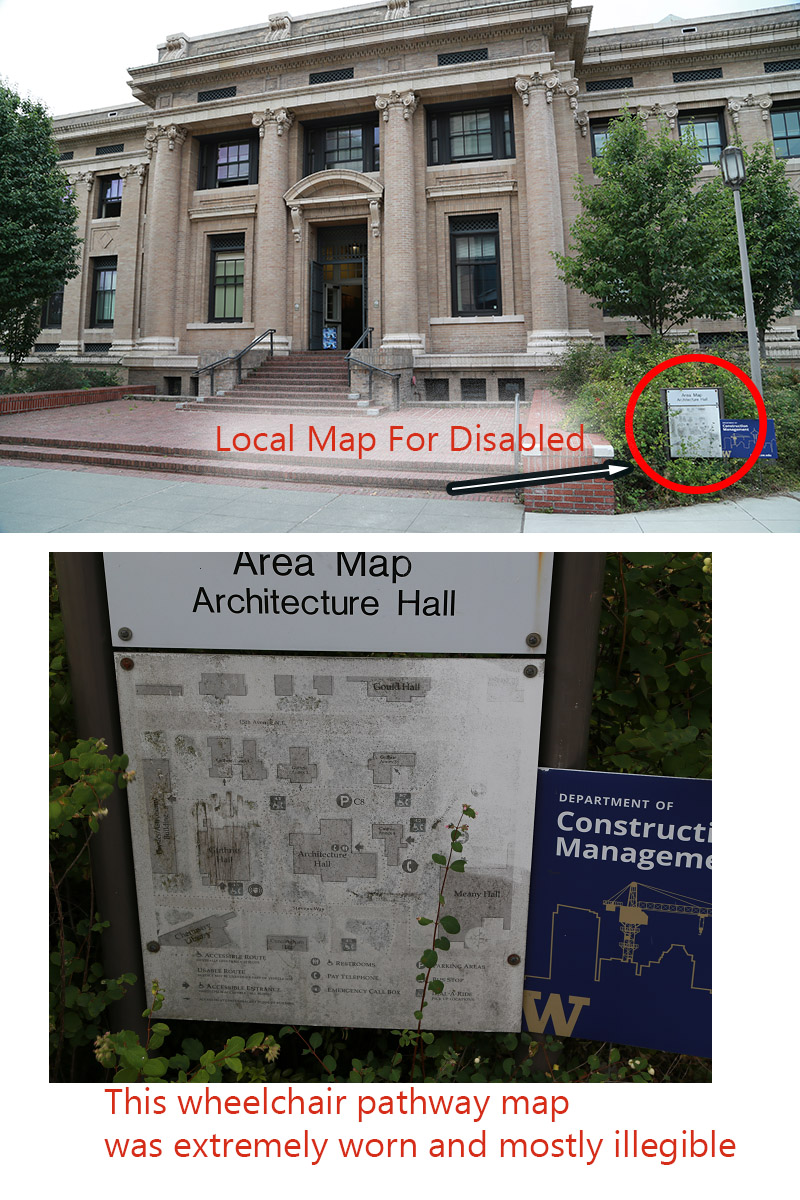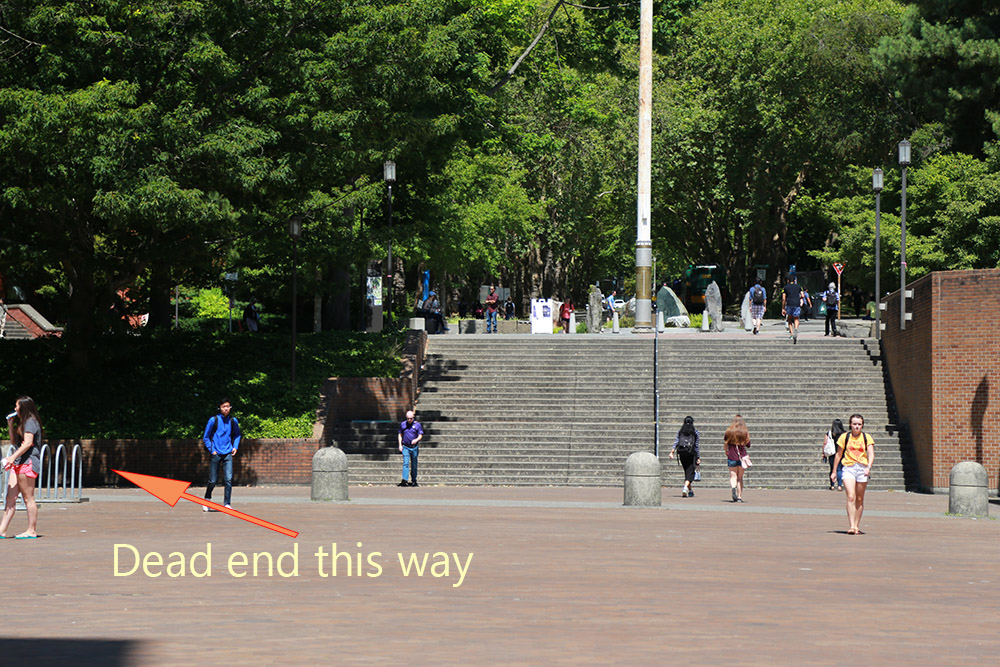Wheelchair accessibility on college campuses still has much room for improvement. We investigated two major universities: Harvard and the University of Washington. Both universities champion diversity and inclusion, and so we wanted to know how well they were doing when it came to disabled students, specifically those who use wheelchairs.
Disabled Students Cannot Browse Campus Libraries
The heart of a university is contained in its library. However, for wheelchair bound students, browsing the libraries at both the UW and Harvard (and these are just two that we sampled) is not possible. According to the American Library Association's website, "The minimum required space between the stacks for wheelchair access is 36 inches. The space that is preferred – and this word makes the difference -- is 42 inches "
Despite the criteria specified in the Americans with Disabilities Act, both campuses have numerous book aisles less than the required 36", let alone the preferred width of 42". Some of the library aisles at both Harvard and the UW are so narrow, they stretch a mere 28" wide, making it impossible for anyone with a wheelchair to move through them.


Disabled students need a minimum of 36" of space to move through an aisle way according to law, with the preferred with of 42". Anything short of 36" fails in ADA compliance, and anything narrower than 32" is outright physically inaccessible.
We visited the office of the vice provost and dean and tried to speak to the dean of libraries at the UW but their office staff would only give us an email address, and when we reached out via email, a communications officer replied to our inquiry stating, "Upon request, library staff in all units will assist with the retrieval of books and with the use of electronic and other bibliographic resources. Time needed for retrieval will vary depending on staff availability. The Disability Services Office will work with a student on a case by case basis as needed for their research or specific course access needs."
While we understand that books higher up in the shelves will require assistance for a student in a wheelchair, the very act of being able to browse stacks is inhibited by narrow aisle widths, making it impossible for these students. For disabled students, being able to simply browse through a library like anyone else is an experience that should be part of their college life, and this kind of inaccessibility falls short of full inclusion.
 |
|
Ironically, the University of Washington was having a disability rights exhibit in its main library at the time of our investigation where numerous aisles are too narrow for wheelchair access
|
 |
| The simple act of browsing through a campus library is off limits to students in wheelchairs. |
But why do so many campuses lag behind in wheelchair accessibility, especially when they go so far forward with gender identify inclusion, even installing non-binary gender restrooms? The reason, according to Hank Falstad, an architect and CEO of ACCESS, an ADA compliance company, is cost.
"As an ADA architect for the past 23 years, I have come to the conclusion that building owners, that includes universities, do not want to spend their money on ADA compliance. However, being that the Americans with Disabilities Act (ADA) is of Federal Civil Rights Law, that ADA decision is put in the hands of a Federal Judge."
ACCESS works alongside the Department of Justice, specializing as architects to bring organizations' buildings and sites into ADA compliance. Colleges have a long ways to go. When it comes to inclusion, university campuses champion themselves as being on the forefront, however implementing inclusion for gender and racial issues is much cheaper than it is to implement inclusion for the disabled, which requires expensive modifications to buildings. This is the primary reason that in the realm of "inclusiveness" the disabled are often the last group of people to be fully welcomed. But does that make it any less important?
Freya Pitts, an attorney for Disability Rights Advocates agrees that colleges are lagging. "Yes, there is much room for improvement in terms of accessibility on college campuses. In fact, DRA is currently litigating a case in federal court in New York, WILC v. SUNY Purchase, that focuses on exactly this – a college that fails to provide students and visitors with equal access because of the widespread barriers across campus." Our investigation of the UW and Harvard is only a small sample of a larger, more widespread issue on our campuses. " Students on campus trying to navigate between dorms, classrooms, parking lots, and other on-campus destinations run into uneven and crumbling pavement, missing curb cuts, dangerously steep slopes, broken down elevators, and woefully insufficient signage for accessible routes, especially routes around construction areas," Freya told us. "Instead of being able to focus on just being college students, students with mobility disabilities on this campus must always be planning how they will navigate around these obstacles and get where they need to go.
A Wheelchair Tour Across Campus
At the University of Washington, we approached the campus from the perspective of a wheelchair bound student, and simulated how easily we could navigate the campus. We quickly found that trying to get from one side of the campus to another was wrought with confusion and obstacles blocking our path. For several buildings, it was not obvious where the wheelchair entrance was. There was a significant lack of signs around buildings instructing people in chairs where to go to enter. In some instances, we followed pathways that terminated at stairways, giving us a complete dead end. In another instance, we accessed a group of buildings by the architectural center, and there was a sign containing a map out front illustrating the wheelchair accessible pathways and building entrances, however the sign was so worn out, parts of it were illegible. The main hub of the campus called "the red square", a vast area leading to numerous buildings has a single ramp to the south end which is obstructed by a lamp post, forcing wheelchairs to roll over vegetation.


Going across the UW campus from north to south, we encountered several navigational difficulties, specifically frequent stairways without any side ramps. A large number of buildings were fronted with stairways without any visible ramps, nor any signage telling someone in a wheelchair which direction to go. For example, when approaching the Department of Applied Mathematics building, we were completely uncertain how to get inside as the main entrance has a ramp-free stairway leading to the front door. There was no sign in front telling us where to go, and had to hunt around the sides of the building where we eventually found an access point in the back.
 |
| It's very easy to get lost, pathways leading to large stairways like this with no ramps anywhere nearby. In this case, those in wheelchairs must go back to the Red Square (main campus area), and go all the way around to the other side and then back in order to reach the top of these stairs- a significant distance. |
Minimum Compliance Vs Full Inclusion
Many in the disabled community see "ADA Compliance" and full inclusion as different entities. For example, even though the University of Washington indeed does have a wheelchair entrance for every building, and even though there is at least one working pathway a wheelchair can use to navigate the campus, this doesn't mean that the campus is "wheelchair friendly". An organization can comply with the ADA on the bare minimum, but in reality the bare minimum often falls short of full inclusion. Imagine a large college campus with hundreds of pathways spanning all over the place, from building to building. Many pathways contain shortcuts from one building to the next, allowing students to quickly get to where they want to go. Now imagine that among these hundreds of pathways, only one exists that is wheelchair friendly. Just one. The student in the wheelchair has to go the long route. Just to get from point A to point B, a mere 100 yards for everyone else, the wheelchair student has to travel 5 times the distance because 99% of every pathway on campus is inaccessible. The wheelchair bound students endure anxiety and stress simply trying to get to their destination, something other students do not deal with. And yet the college calls itself "ADA Compliant". Yes, it may be legally compliant, but that doesn't mean it is fully inclusive.
Universities need to provide equal access for students with all types of disabilities. This doesn't mean colleges aren't making an effort, however. Ian Ruder, Editor of New Mobility Magazine with the United Spinal Association and a former disabled student himself told us, "On every campus in America you can find a number of accessibility problems that are in violation of the ADA. Addressing these is a must, but a proactive attitude and a general willingness on behalf of the administration and the university to address disability obstacles in an open and efficient manner is even more important.” This means that for many disabled students, it is the willingness of a university to address accessibility problems that counts more than the existing obstacles themselves.
Arthur Hunter is a computer programmer and co-founder of Theravive. He has been in the tech industry for over 20 years, with multiple Microsoft certifications. He has a love and passion for the intersection of technology and mental health and how the gadgets we use and the time we spend on them play a part in our mental well being, for better or worse. Together with his wife in 2007 they founded Theravive, which currently has thousands of licensed therapists and psychologists. He enjoys writing on occasion, reporting on mental health and technology. You can reach Arthur at 360-350-8627 or write him at webadmin - at - theravive.com.